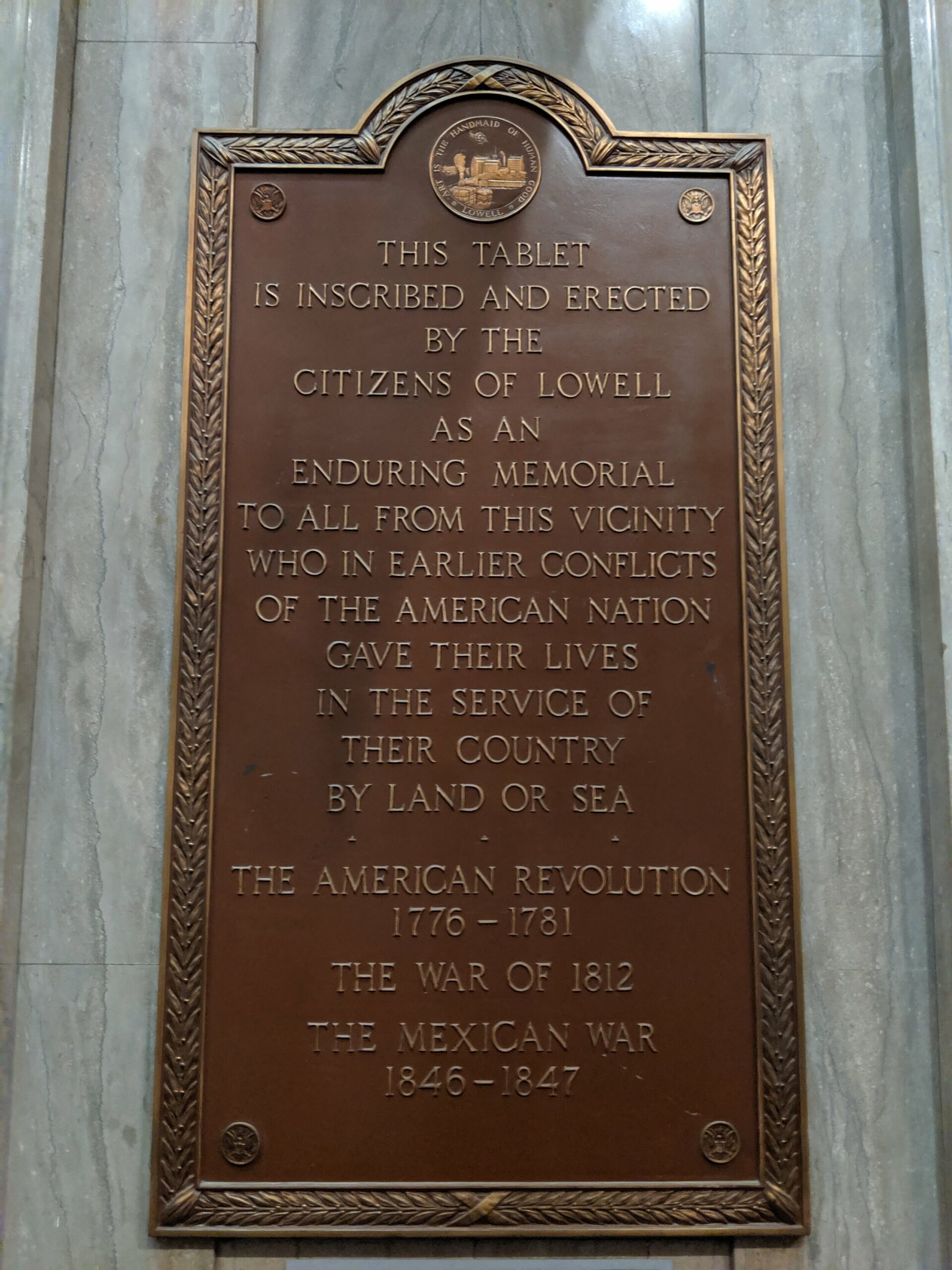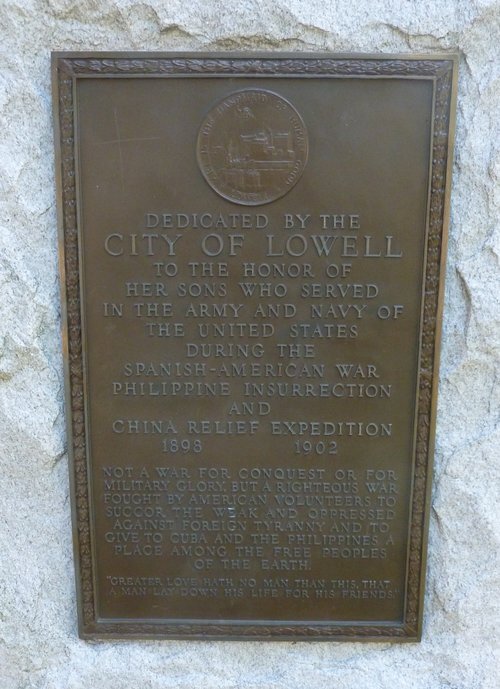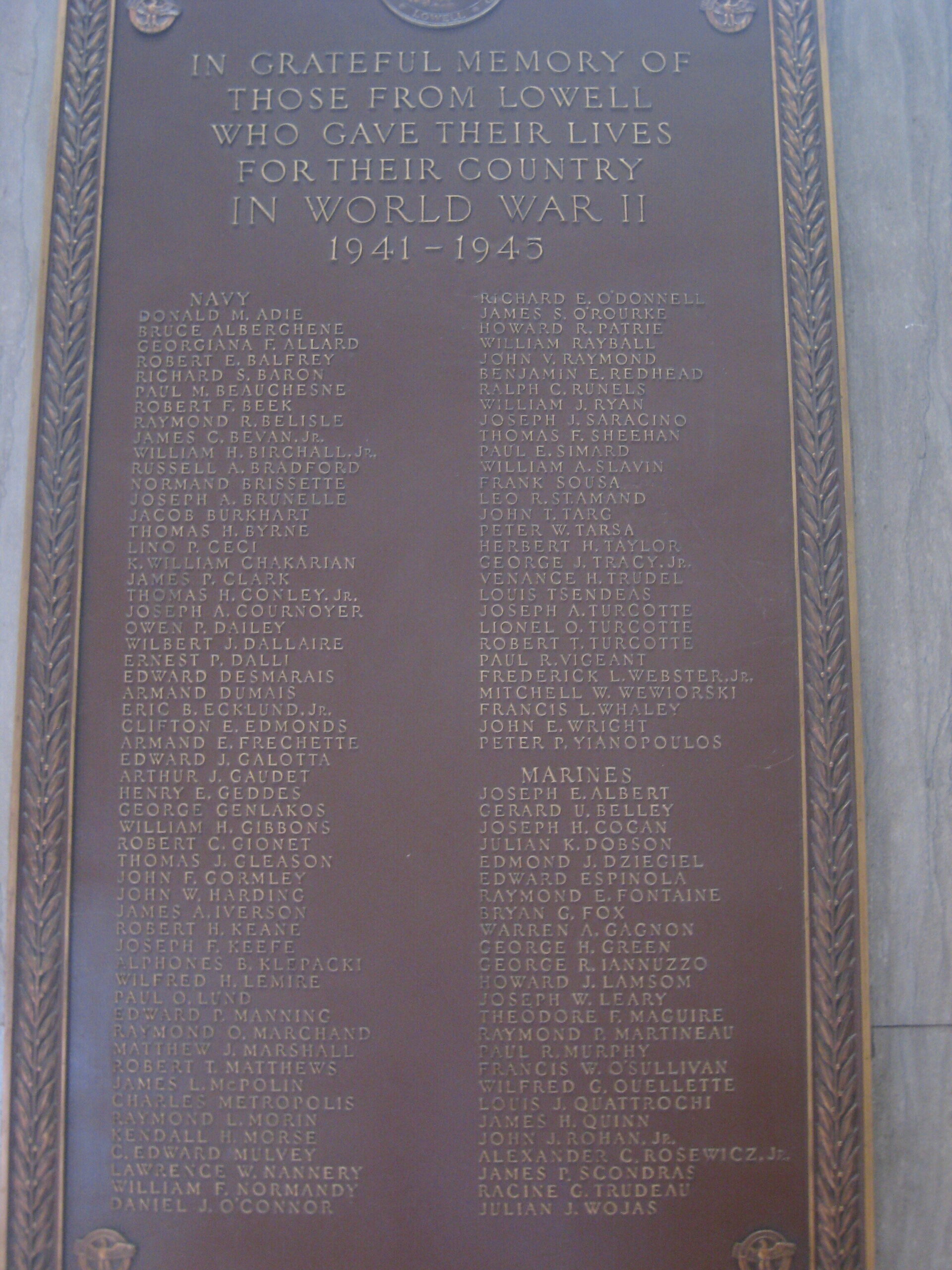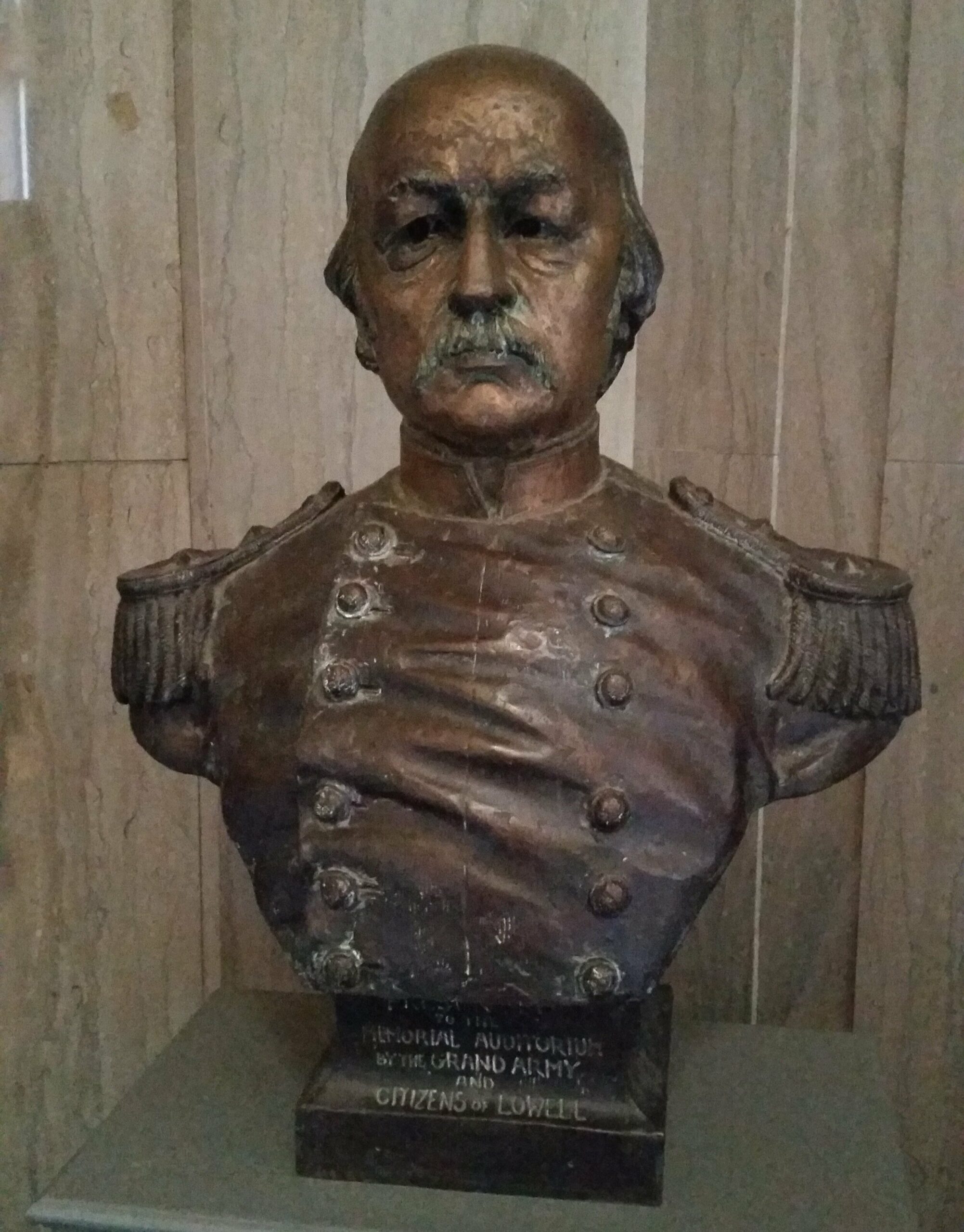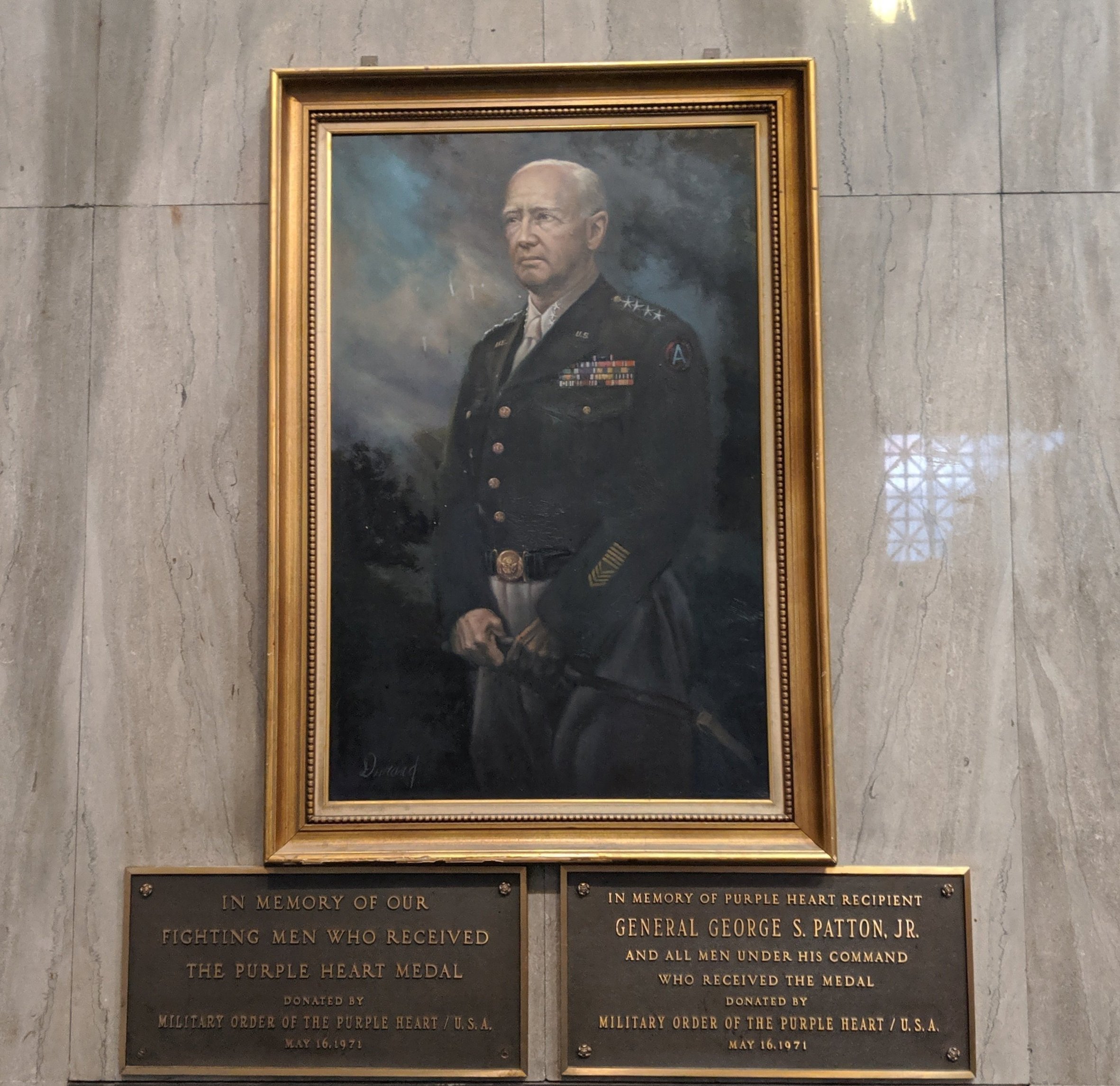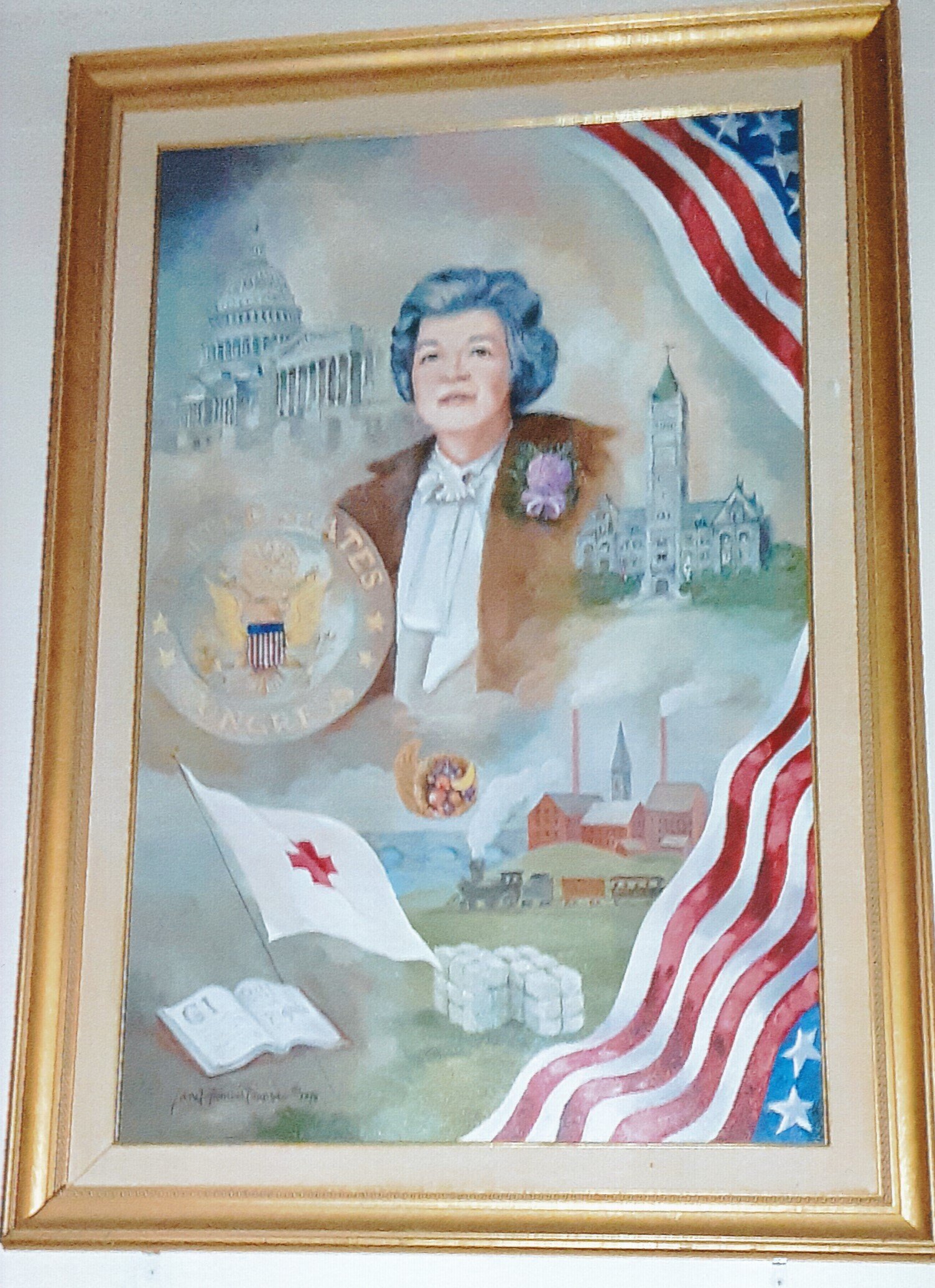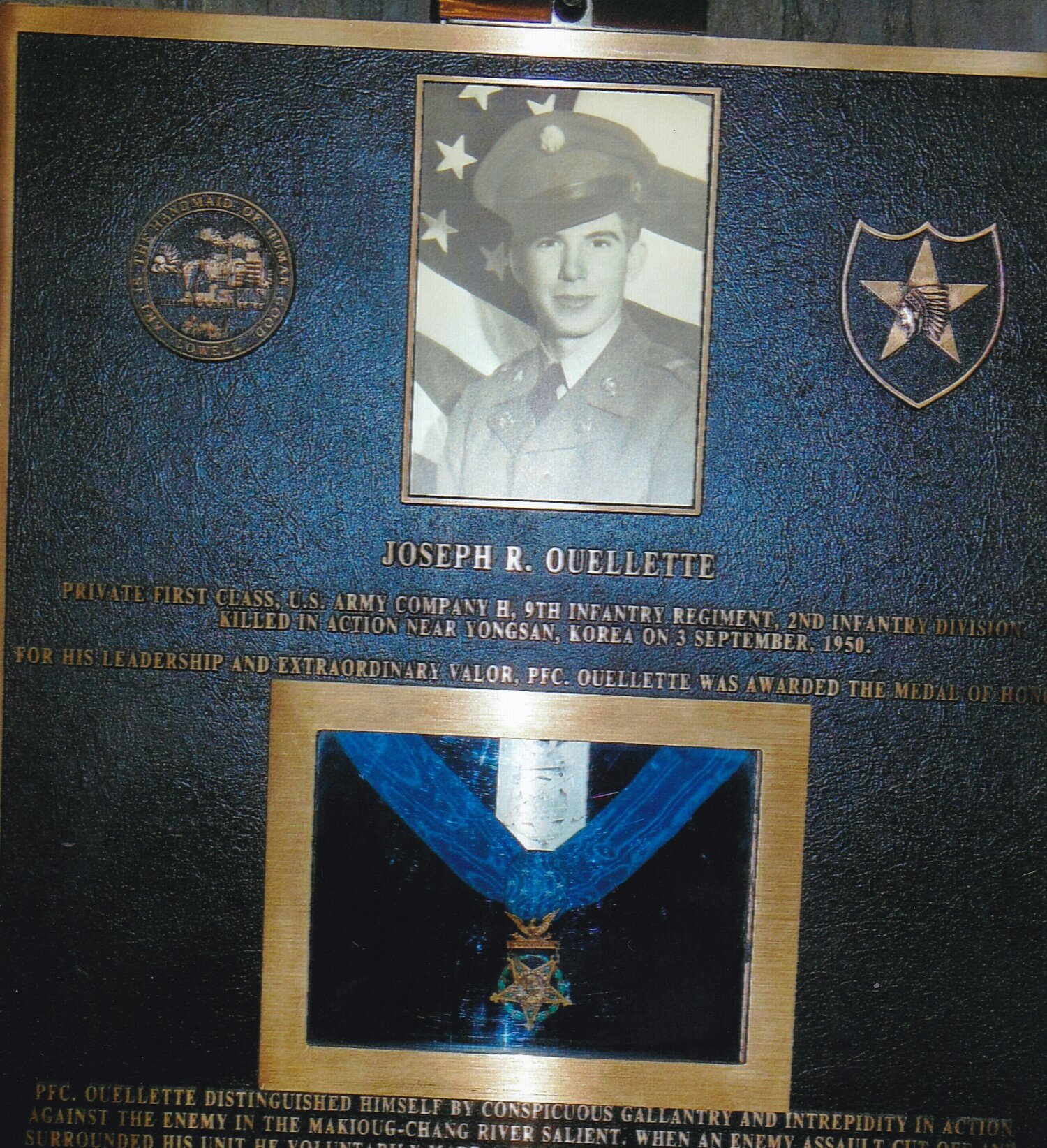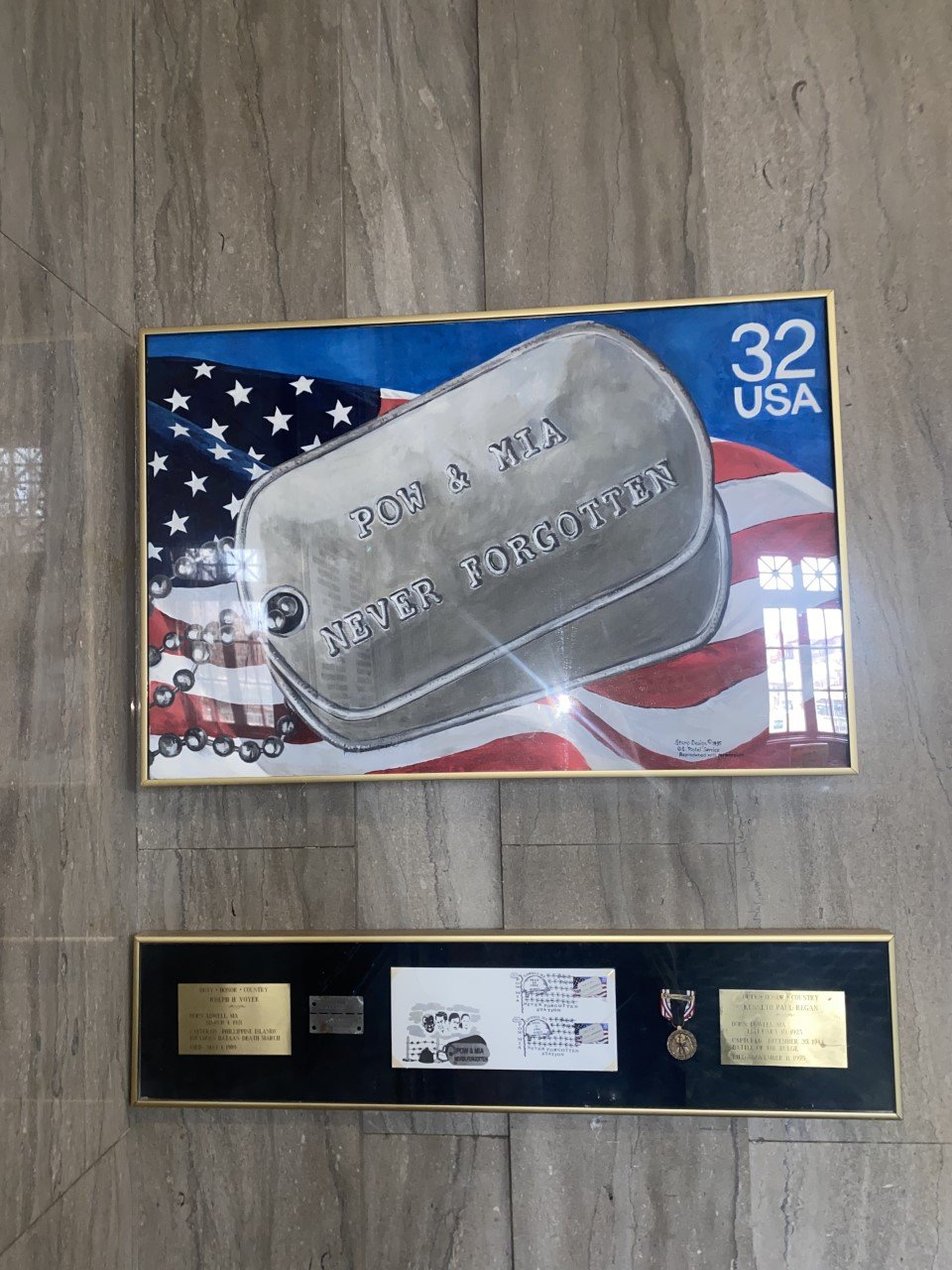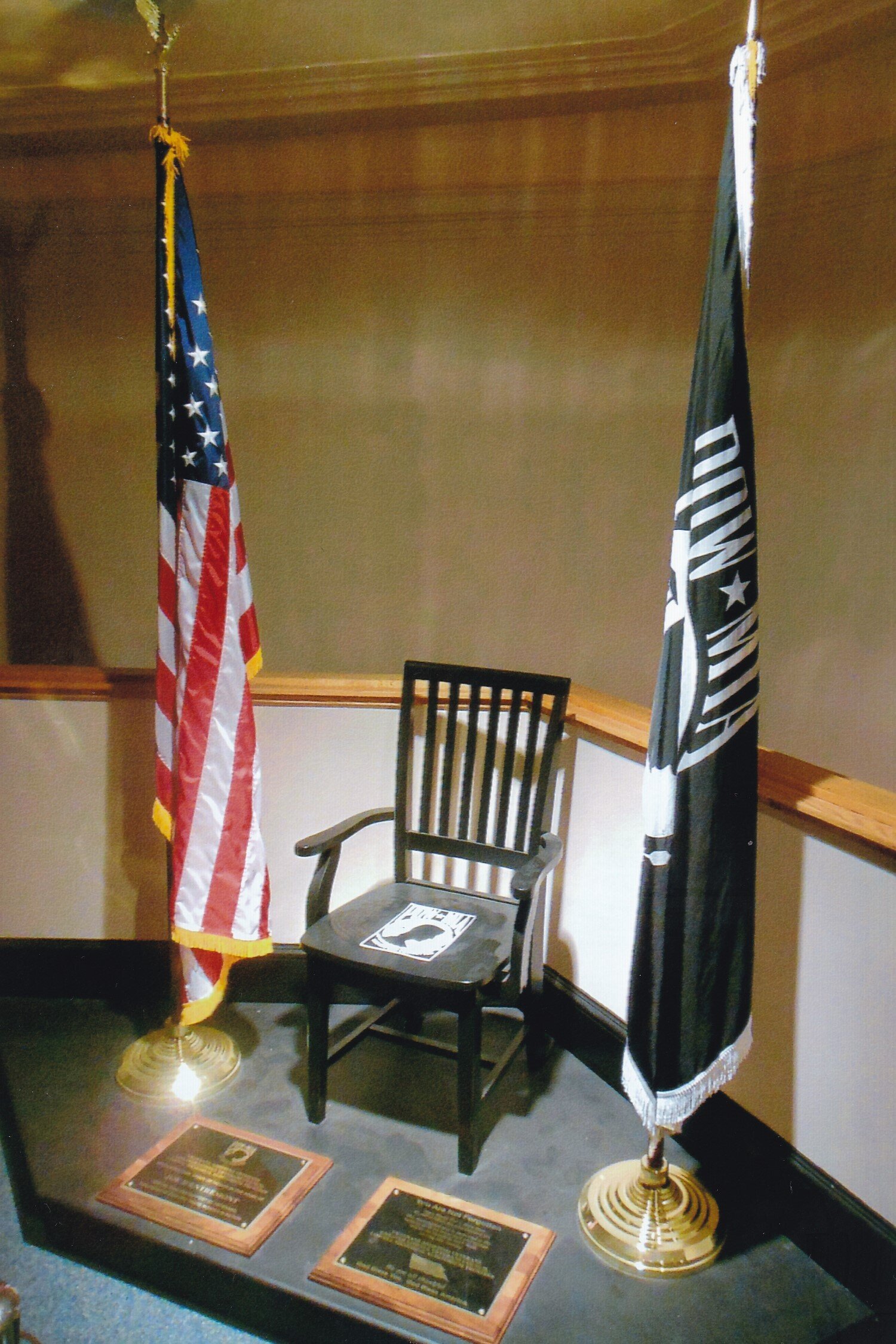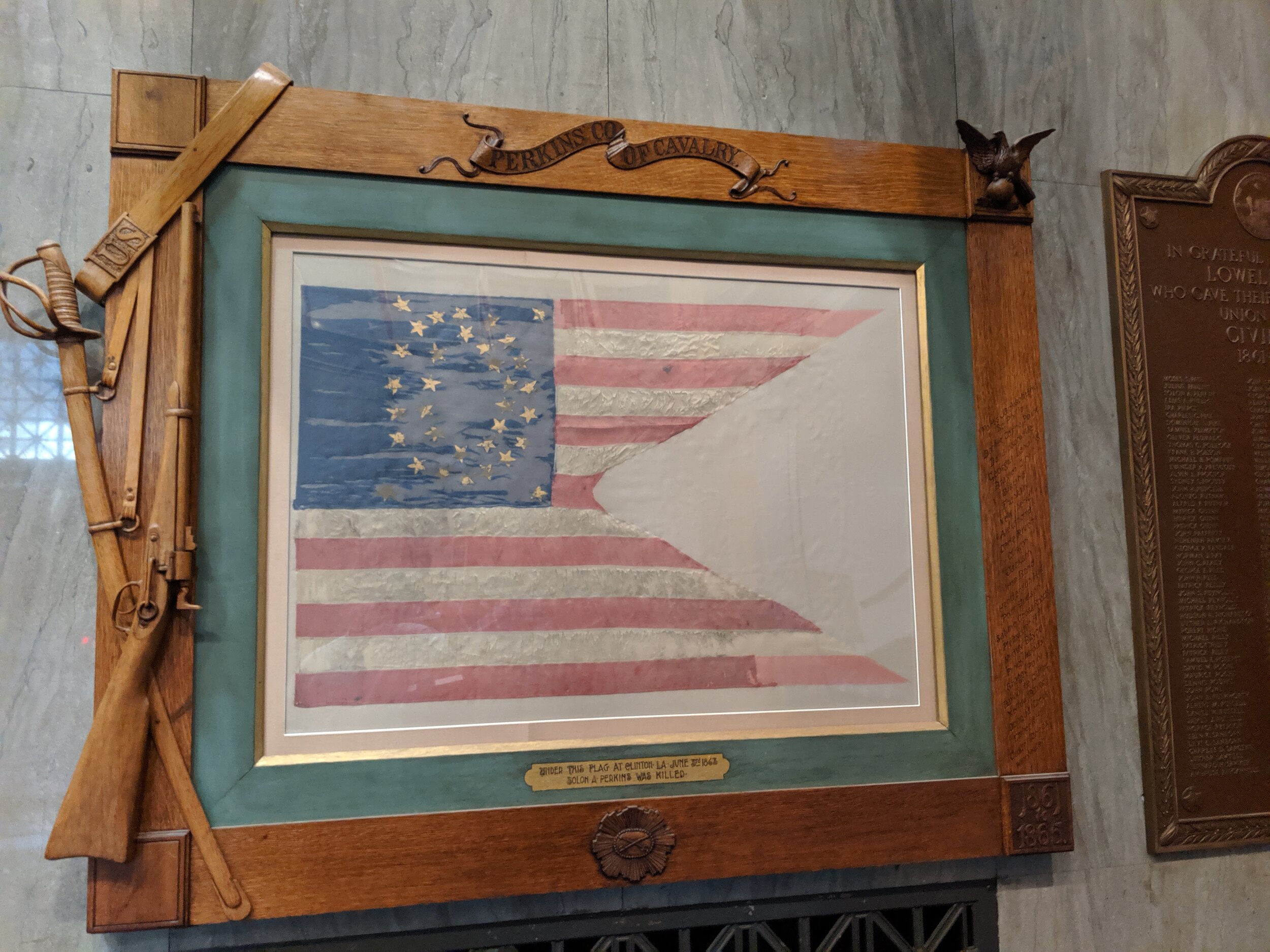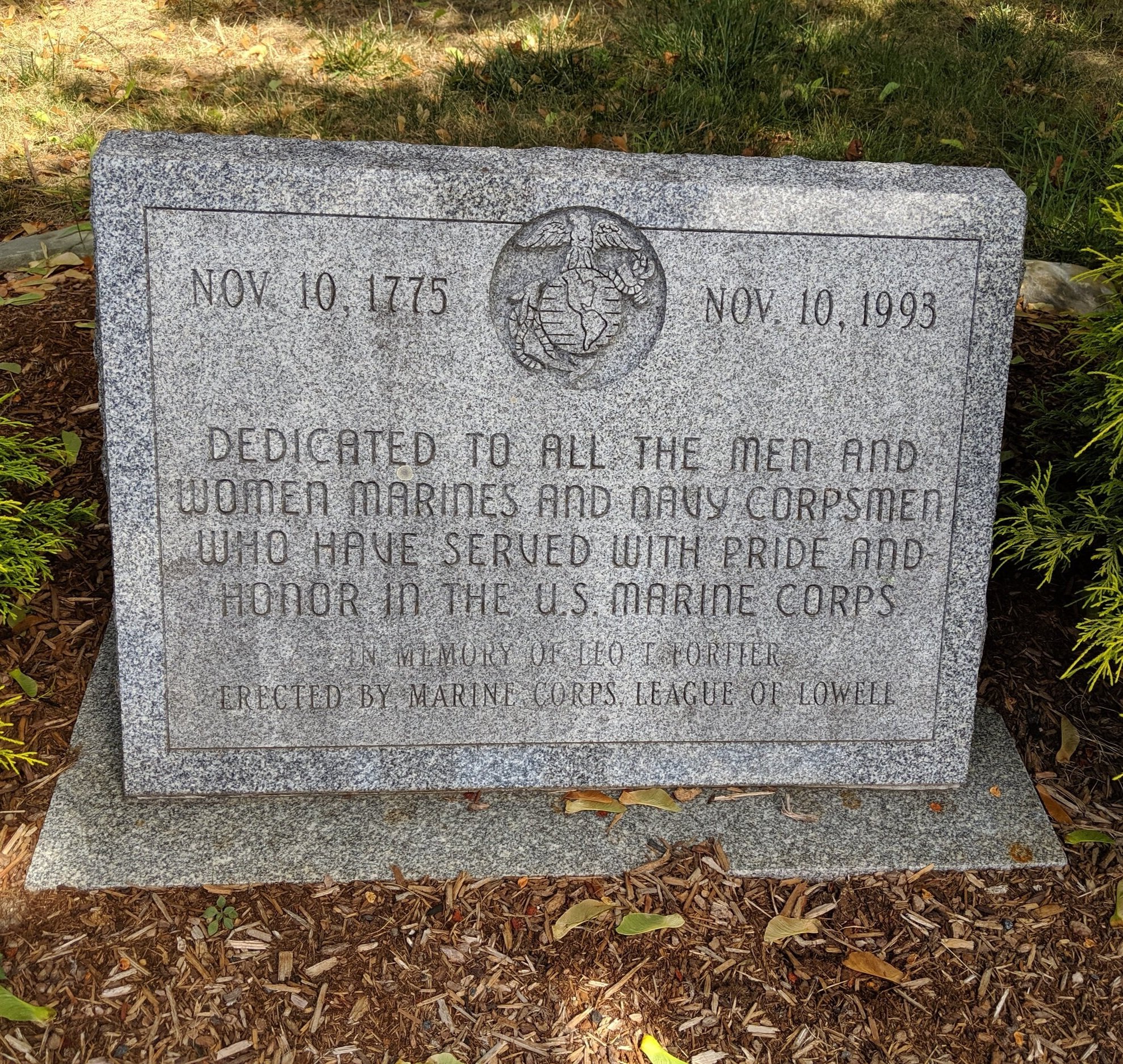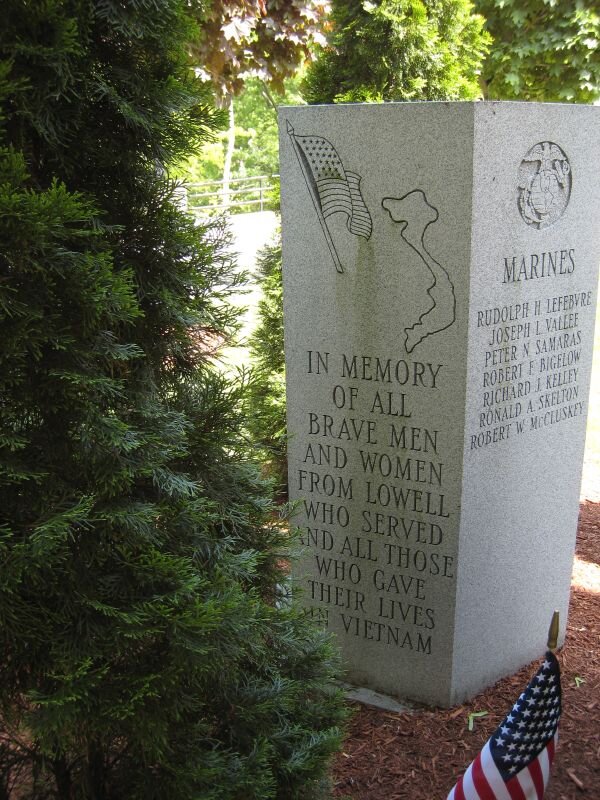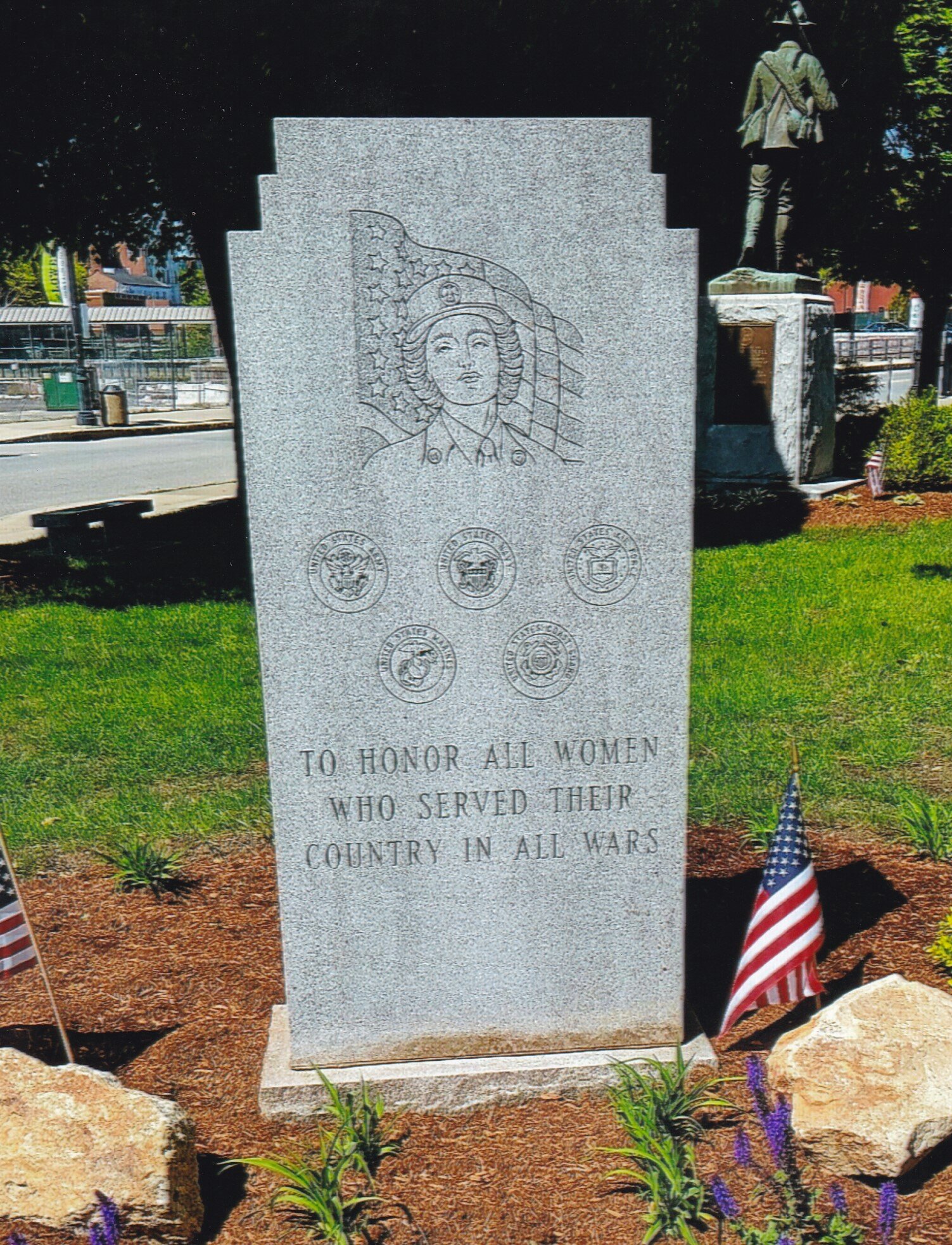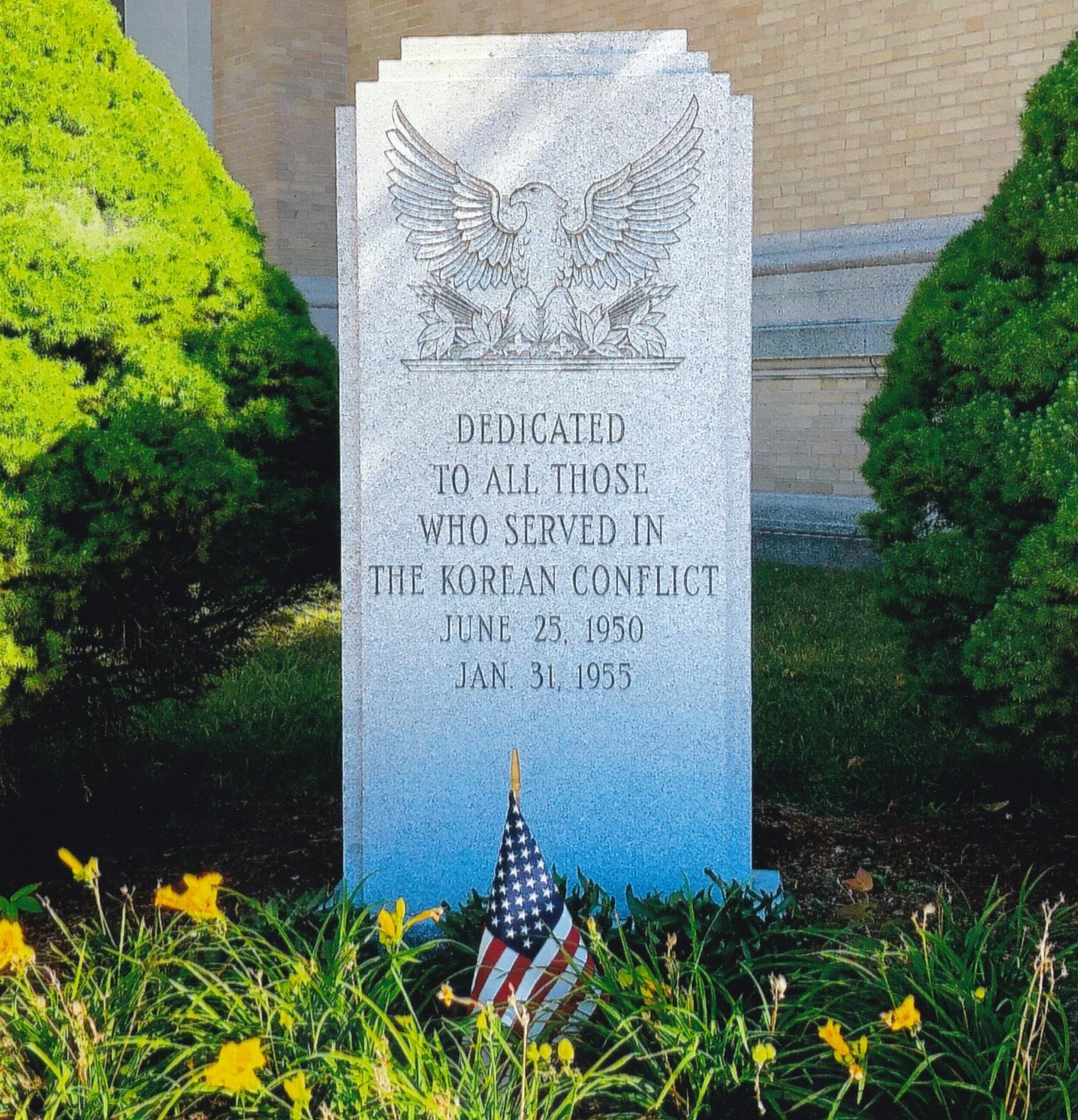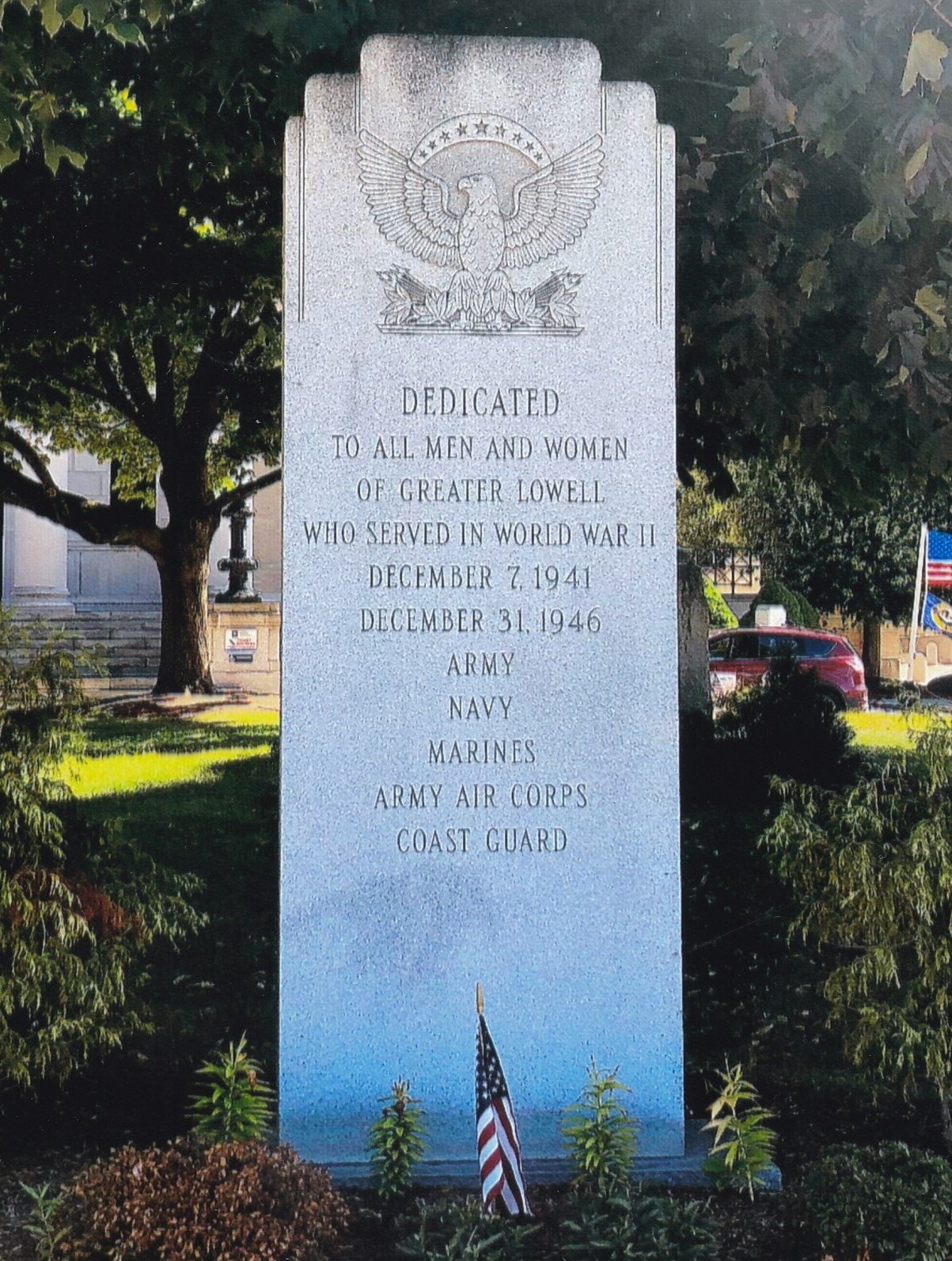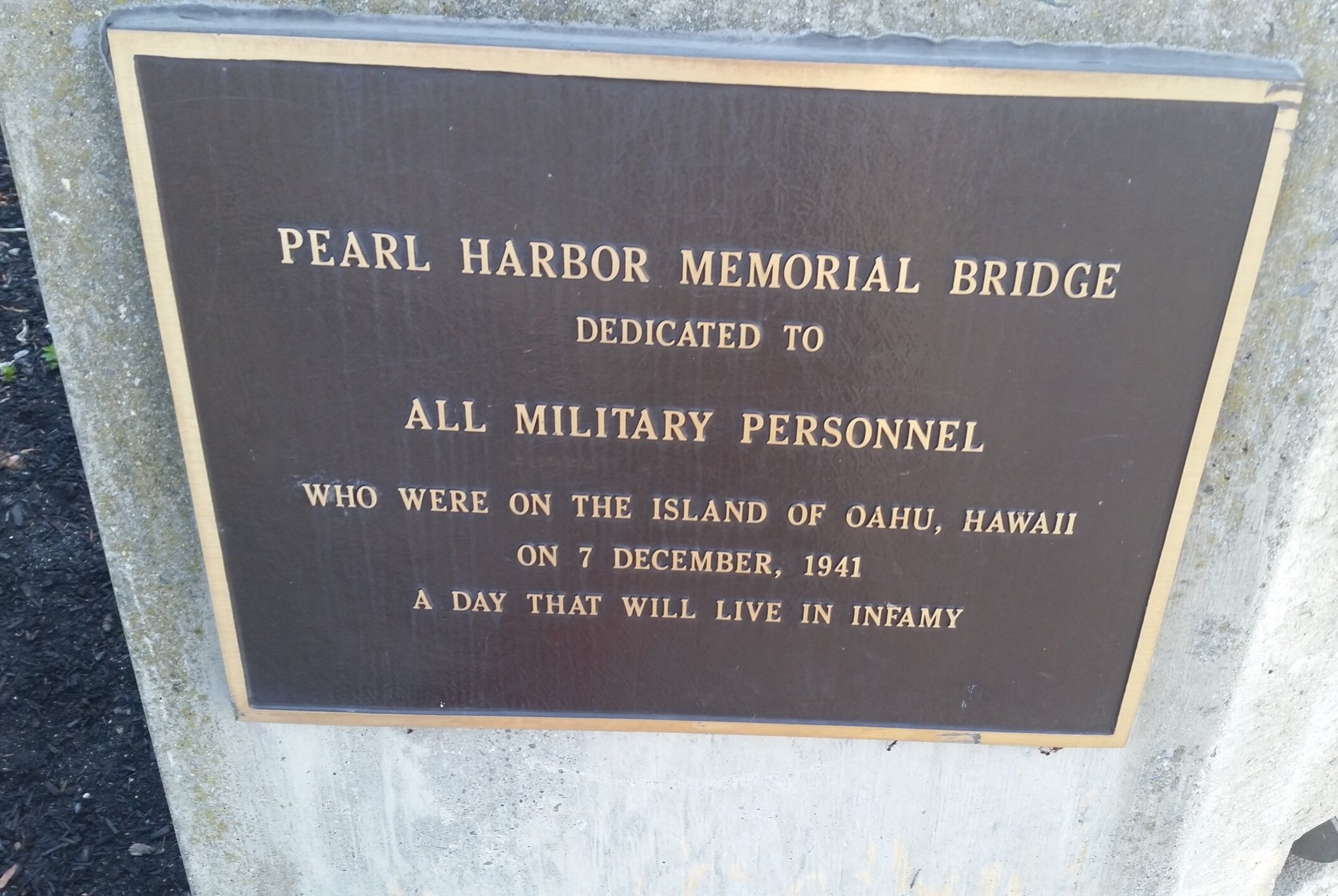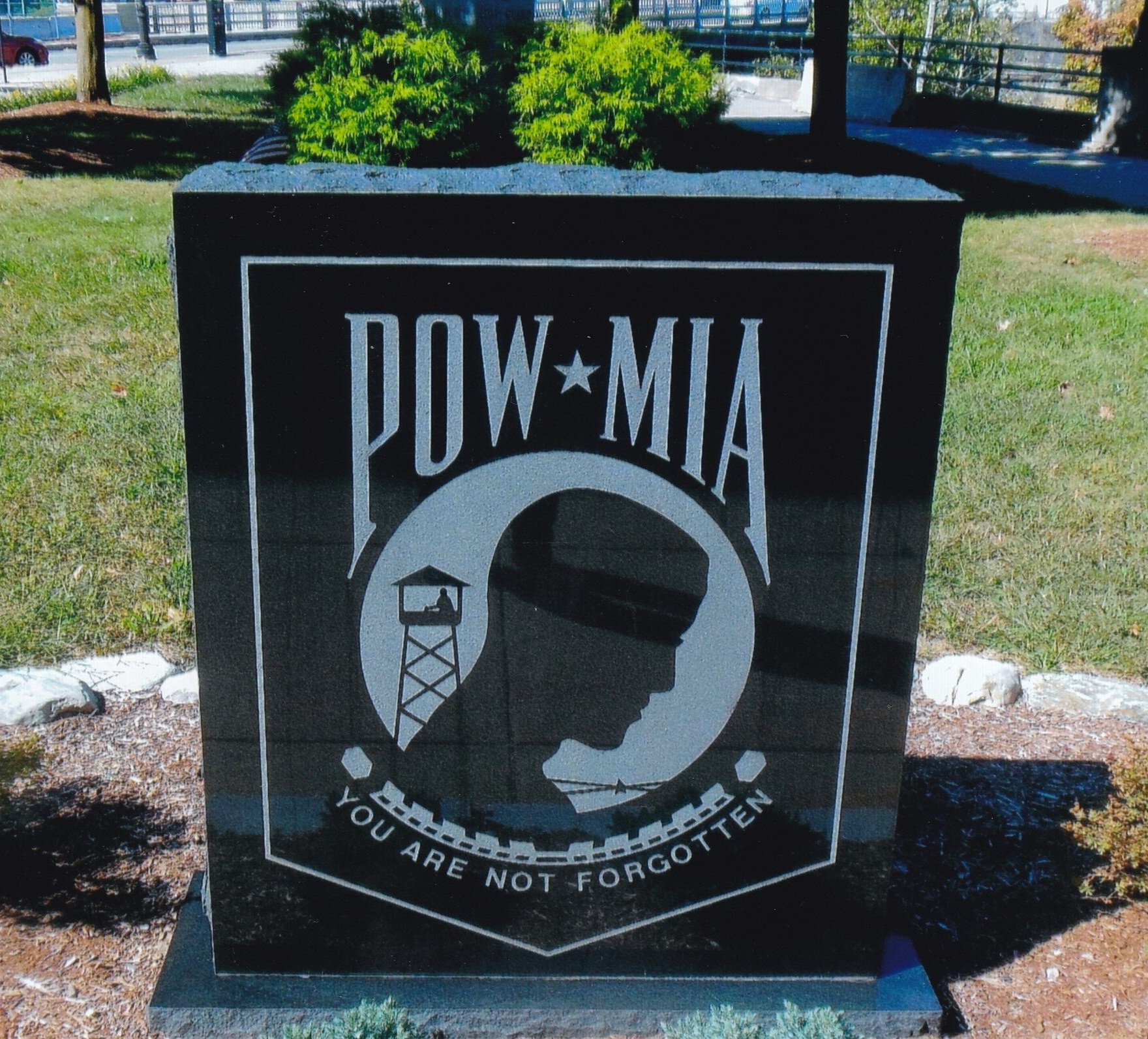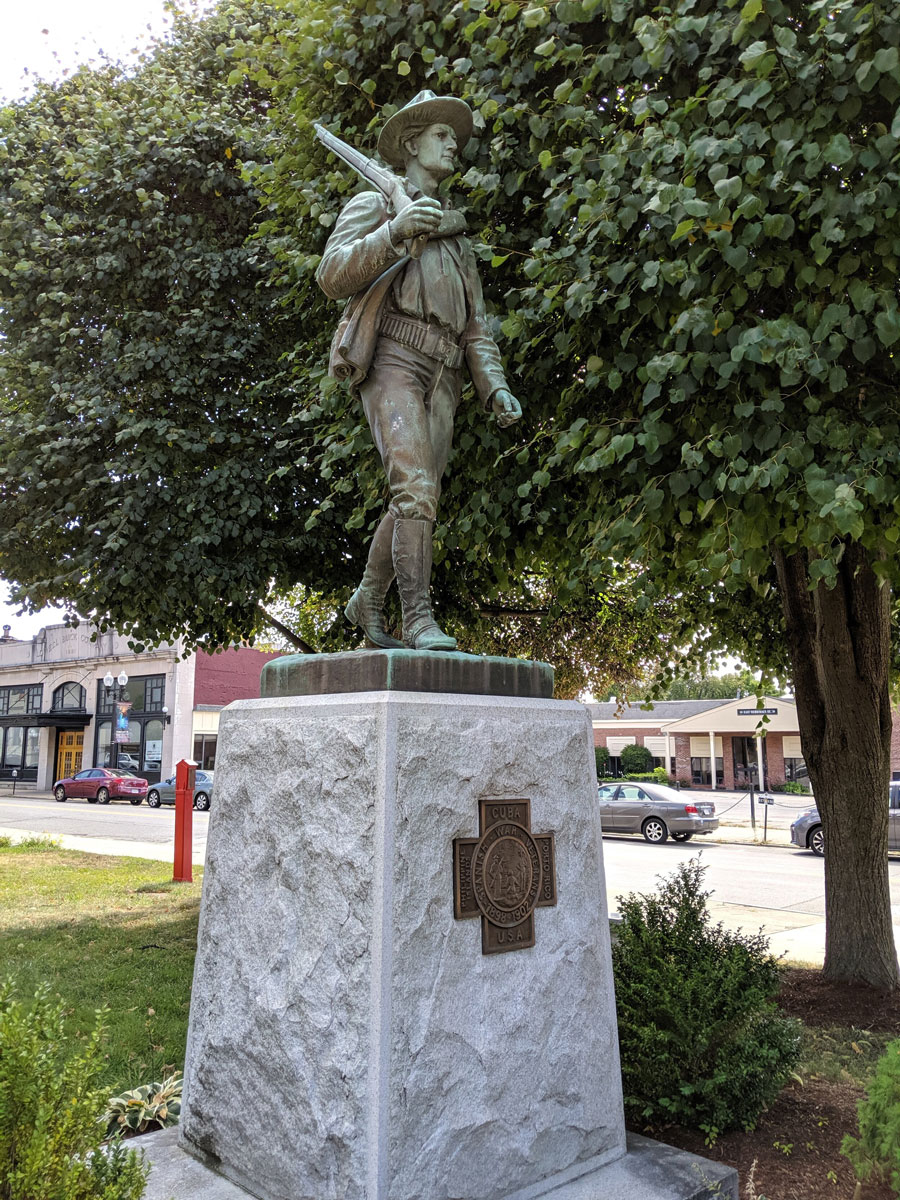MONUMENTS & MEMORIALS
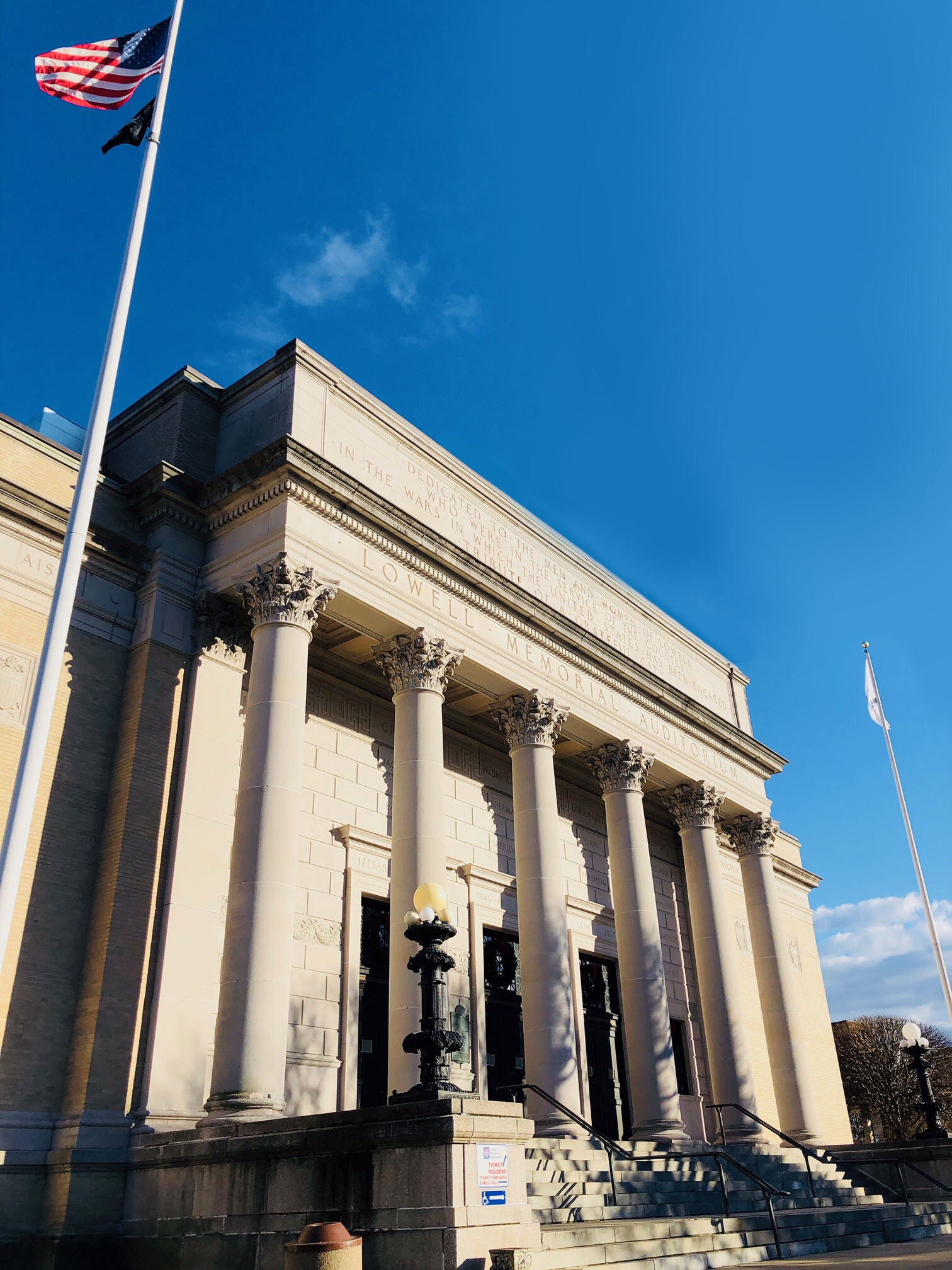
THE LOWELL MEMORIAL AUDITORIUM
In 1919, the Massachusetts state legislature passed a bill that authorized the city of Lowell to obtain land and expend funds for the erection and maintenance of a public building in the city to be known as the Lowell Memorial Auditorium. The cornerstone was laid on September 25, 1920 and the building opened on September 21, 1922. The building consisted of a main auditorium with a second venue of 675 seats called Liberty Hall. From its opening until the present day, the Lowell Memorial Auditorium has hosted a variety of conventions, civic and religious programs, the Golden Gloves amateur boxing competition, and performances by the biggest names in American entertainment.
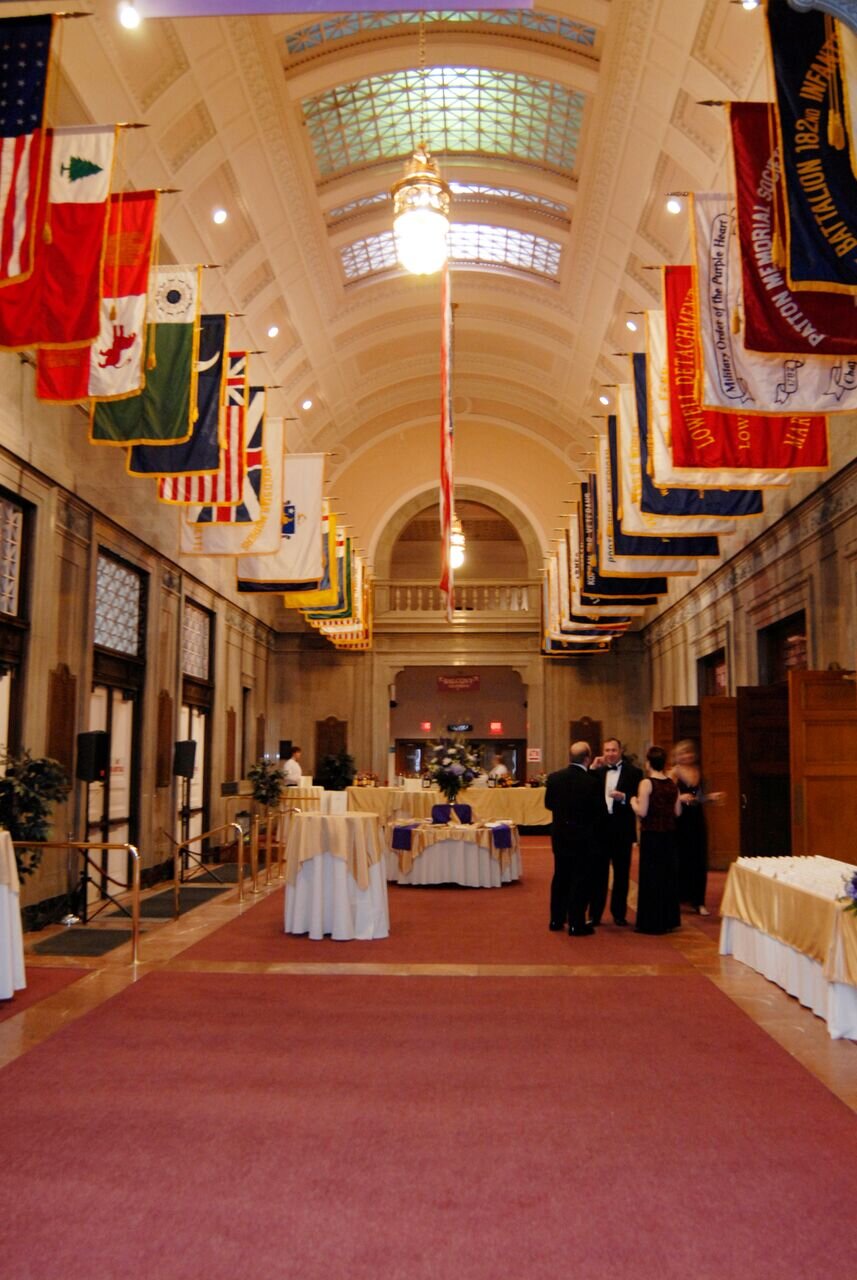
THE HALL OF FLAGS
The great entry foyer of the Lowell Memorial Auditorium displays artifacts that honor and remember the veterans of Lowell. Originally called Trophy Hall, the room was initially intended to display “trophies of war” such as battle flags and weapons captured from defeated enemies. However, Auditorium Trustees in conjunction with veterans’ organizations concluded that Trophy Hall should instead be used to honor Lowell residents who died in the military service in time of war. In a dignified ceremony on November 30, 1924, veterans’ organizations, elected officials and members of the public unveiled wall-mounted bronze tablets honoring those who had died in the Civil War, the Spanish-American War, World War I, and in earlier wars in which the United States was involved. Through the years, a number of tablets, plaques, paintings and artifacts honoring veterans have been placed in the Hall of Flags. The items on display in 2023 are described below.
AMERICAN REVOLUTION TABLET
On November 30, 1924 the city of Lowell, the various veterans groups in the city, and the Auditorium trustees held a formal ceremony to unveil bronze tablets honoring the residents of Lowell who had died while serving in the military in the wars fought by the United States up until that time. The first tablet honored those from this area who had fought in the Revolutionary War, the War of 1812 and the Mexican War. The tablet inscription is “This tabled is inscribed and erected by the citizens of Lowell as an enduring memorial to all from this vicinity who in earlier conflicts of the American nation gave their lives in the service of their country by land or sea: The American Revolution, 1776 – 1781; The War of 1812; The Mexican War, 1846 – 1847.” (Photo courtesy of RPH.)
SPANISH-AMERICAN WAR TABLET
A tablet for the Spanish-American War dead from Lowell contains 32 names and bears the inscription “In grateful memory of all Lowell men who gave their lives for their country in the war against Spain or who perished in the destruction of the U.S.S. Maine in Havana Harbor 1898.”
WORLD WAR II TABLETS
On Sunday, May 1947, four tablets inscribed with the names of the 436 residents of Lowell who died while in the military service during World War II were unveiled in the Hall of Flags. The names are organized by branch of service with two tablets for the United States Army (320 names). A third tablet combines the United States Navy (84 names) and United States Marine Corps (25 names). At the top of each tablet is the inscription “In grateful memory of those from Lowell who gave their lives for their country in World War II 1941 – 1945.” A fourth tablet, bearing the inscription, “This tablet is dedicated to the memory of these Lowell men who made the supreme sacrifice in World War II 1941 – 1945” lists those lost in the Merchant Marine (five names); the American Field Service (one name); and as an American War Correspondent (one name).
KOREAN WAR TABLET
On Sunday, May 27, 1956, a bronze tablet bearing the names of 17 Lowell service members who died in the Korean War was dedicated in a ceremony in the Hall of Flags following the city’s Memorial Day parade. Above the names, the plaque is inscribed “In grateful memory of those from Lowell who gave their lives for their country in the Korean War, 1950 – 1953.”
VIETNAM WAR TABLET
On Sunday, October 21, 1973, a bronze tablet containing the names of 21 Lowell service members (14 in the Army and 7 from the Marine Corps) who died in the Vietnam War was dedicated in a ceremony in the Hall of Flags. Above the names the plaque reads “In grateful memory of those from Lowell who gave their lives for their country in the Southeast Asian War, 1964 – 1973.”
SCOTT FINNERAL PLAQUE
A Lowell native who enlisted in the Navy after graduating from Lowell High in 1988, Scottie Finneral and five comrades were killed when their MH-53 minesweeping helicopter plunged into the Persian Gulf during the first Gulf War. This plaque in his memory was dedicated on November 11, 1998, as part of the city’s Veterans Day ceremonies. The plaque reads “In grateful memory of Machinist 3/C George Scott Finneral, United States Navy of Lowell, Massachusetts, who gave his life for his county in the Persian Gulf War, September 14, 1991.”
BENJAMIN F. BUTLER
A bust of Benjamin F. Butler was presented to the city of Lowell on Thursday, May 22, 1930 by the Grand Army of the Republic. Sculpted by Lucien Gosselin of Manchester, New Hampshire, the all-bronze bust sits atop a marble pedestal which bears a plaque which reads “Benjamin F. Butler, Major General; Brigadier General of Massachusetts Militia 1861; Military Commander of New Orleans, 1862; Commanded Army of the James, 1863; Elected to Congress from Massachusetts, 1867-1875 and 1877-1879; Elected Governor of Massachusetts, 1882; Presidential Candidate, 1884.” A prominent lawyer and politician who served in Congress, ran for president, and was governor of Massachusetts, Ben Butler is perhaps best remembered for his Civil War military service. Butler died in Washington, D.C. in 1893 at age 74. He is buried in the Hildreth Family Cemetery in Lowell.
PATTON PORTRAIT AND PLAQUE
On May 16, 1971, the same day that the adjacent Purple Heart plaque was dedicated, Ruth Patton Totten unveiled a portrait of her father, General George S. Patton Jr. and an accompanying plaque inscribed “In memory of Purple Heart recipient General George S. Patton, Jr. and all men under his command who received the medal. Donated by Military Order of the Purple Heart/USA, May 16, 1971.” The portrait which was painted by Oscar Durand of Manchester, N.H. and the unveiling event were organized by the Lowell-based Patton Memorial Society.
MILITARY ORDER OF THE PURPLE HEART
On Sunday, May 16, 1971, Ronald Beattie, the national commander of the Military Order of the Purple Heart, unveiled a plaque which honors all recipients of the medal. The plaque is inscribed “In memory of our fighting men who received the Purple Heart Medal, donated by Military Order of the Purple Heart/USA, May 16, 1971.”
EDITH NOURSE ROGERS PORTRAIT
After the sudden death of her husband, John Jacob Rogers, in 1925, Edith Nourse Rogers succeeded him in Congress and served there until her own death in 1960. Though a Republican, she was a strong supporter of President Franklin Roosevelt’s New Deal. During World War II, she sponsored the legislation that created the Women’s Auxiliary Army Corps (WAC) and helped draft the GI Bill which established financial and educational benefits for veterans. This portrait of Rogers by Janet Lambert Moore was unveiled on May 24, 1998. The portrait is accompanied
by a plaque that reads “Edith Nourse Rogers, March 19, 1881 – September 10, 1960, Member of the House of Representatives, Massachusetts 5th District, 1925 – 1960, Mother of the G.I. Bill.”
JOSEPH OUELLETTE MEDAL OF HONOR DISPLAY
Cut off by the massive North Korean assault on the Pusan Perimeter, 20-year old US Army PFC Joseph R. Ouellette of Lowell performed countless acts of extreme heroism that ensured the survival of his 2nd Infantry Division comrades but cost him his life. His posthumous Medal of Honor was presented to his mother by General Omar Bradley. In 2007, Ouellette’s family donated his medal to the Greater Lowell Veterans Council for display in the Hall of Flags where an unveiling ceremony was held on Saturday, September 8, 2007.
POW/MIA DISPLAY
This display features an enlarged image of the 32 cent POW & MIA stamp issued by the US Postal Service on May 29, 1995. The purpose of the stamp is to remember those who have not returned (MIA or missing in action) and to thank those who endured captivity and came back as heroes (POW or prisoner of war).
Duty, Honor, Country
Kenneth Paul Regan, born: Lowell, MA., February 10, 1923.
Captured: December 20, 1944, Battle of the Bulge.
Died: November 11, 1995
Duty, Honor, Country.
Joseph H Voyer, Born Lowell MA, March 4, 1921.
Captured Philippine Islands infamous Bataan Death March.
Died: March 1, 1985
Also on display are a Prisoner of War medal, a prisoner of war ID tag, and an envelope bearing the twin Lowell, Mass cancellations of May 29, 1995 (day of issue of stamp) and November 11, 1996 (day of dedication of display).
POW/MIA CHAIR OF HONOR
Veterans Assisting Veterans, the Greater Lowell Veterans Council and the Lowell Memorial Auditorium Trustees dedicated a Chair of Honor to honor American service men and women who are prisoners of war or missing in action (POW/MIA). The simple black chair sits on a raised platform within the main hall of the Auditorium where it is flanked by the flag of the United States and the POW/MIA flag. A plate on the seat of the chair displays the POW/MIA symbol. Plaques on the platform at the foot of the chair state:
You are not forgotten Since World War I, more than 91,000 soldiers are unaccounted for. This unoccupied seat is dedicated to the memory of those brave men and women and to the sacrifices each made serving this country.
God Bless You. God Bless America.
The second plaque dedicates the chair to Joe D’Entremont “for his tireless support of veterans, prisoners of war and those missing in action.”
SOLON PERKINS FLAG
Captain Solon Perkins of Lowell was killed in action on June 3, 1863, at Clinton, Louisiana, while leading a troop of Union Cavalry. After the Civil War, his comrades presented the flag they carried throughout the war to Perkins’ mother. A relative commissioned an ornate wooden frame for the flag which decades later ended up forgotten in a basement storage room of the Lowell Memorial Auditorium. In January 2014, Auditorium employees rediscovered the flag which was then restored by the Greater Lowell Veterans Council. The flag and its refurbished frame were unveiled on May 31, 2015, as part of the city’s Memorial Day ceremony.
Soon after the Lowell Memorial Auditorium opened, its manager obtained replicas of 40 flags from early American history and displayed them high on the walls of Trophy Hall. The flags were an immediate attraction and the space soon came to be called the Hall of Flags. Through the years, some of the historical flags have been replaced by those of the member organizations of the Greater Lowell Veterans Council. In 2019, a total of 46 flags are displayed: 27 of Veterans Council organizations, 18 from early American history, and the state flag of the Commonwealth of Massachusetts.
A description of each of the flags follows beginning with the flag on the outer wall closest to East Merrimack Street. In describing the flags a “canton” is a rectangular area, usually at the top hoist corner of the flag, such as the blue field and white stars on the US flag. A “jack” is a flag hoisted on the bow of a naval vessel when it isin port or at anchor.
Bucks of America Flag – An African-American company of the Massachusetts militia during the American Revolution became known as the Bucks of America. There is no history of the company facing British troops but it did provide valuable security service in Boston during the war. In 1789, Governor John Hancock honored the company by presenting it with this flag which features a leaping buck in front of a pine tree on a golden field with a blue canton containing 13 white stars.
American Flag of 20 Stars – When each state beyond the original 13 joined the union, an additional star and an additional stipe were added to the flag. However, the increased number of stripes risked distorting the appearance of the flag so Congress in 1818 decreed that the flag would revert to the original 13 stripes but that a new star would be added for each new state. This is the first flag created after that decree.
Flag of Columbus (Castile and Leon) – This flag has alternating red and white quarters with a gold castle on the red quarters and a red lion on the white quarters. It is the flag of the Spanish autonomous region (the rough equivalent of a U.S. state) of Castile and Leon. The flag first appeared in the 1300s and is believed to have been carried by Columbus when he came to the Americas.
Independent Company of Newburyport – This flag consists of a green field with a white canton that contains 13 silver mailed (armored) hands clasping a circular chain of 13 links. Within the circle is a blue globe. This is a variant of the flag that the Independent Company of Newburyport carried during the Revolutionary War. The common depiction of that company’s flag had a blue canton with a pine tree in the center of the chain but was in all other respects identical to this flag.
First Navy Jack – This flag consists of 13 alternating horizontal stripes of red and white with an extended rattlesnake and the words “Don’t tread on me.” The flag purports to be the first “jack” of the US Navy, however, the best evidence is that the first navy jack had the alternating red and white stripes, but no rattlesnake or words. Those items appeared in a 19th century print which is the basis of this flag.
Bunker Hill Flag (red) – This red flag with a pine tree in a white canton is depicted in the original version of Connecticut artist John Trumbull’s “The Death of General Warren at the Battle of Bunker’s Hill, 17 June 1775” painting. As is the case with this flag, the flag in Trumbull’s painting did not have a Cross of St. George in the white field, just a pine tree.
Moultrie Flag – Also known as the “Liberty Flag,” this blue flag with a white crescent containing the word “Liberty” was commissioned by Colonel William Moultrie in 1775. It flew over Fort Moultrie at the entrance to the harbor at Charleston, South Carolina, during the unsuccessful British assault in June 1776
Grand Union Flag – This flag with 13 alternating red and white horizontal stripes with the British Union Jack in the canton was flown by George Washington during the siege of Boston in 1775-76. The Flag Act of 1777 replaced the British Union Jack on this flag with the better-known blue field with white stars.
Flag of Great Britain (Union Jack) – This flag was used by naval forces of Great Britain from 1707 until 1801. During the French and Indian War, militia troops from New England would have fought under this flag. The flag consists of the combined crosses of England and Scotland laid on a blue field. (In 1801, a red X was added to represent Ireland).
Gold Star Mothers – The flag is white with “American Gold Star Mothers Chapter 7 Lowell Massachusetts” in gold letters above and below a large gold star.
Commonwealth of Massachusetts – The Massachusetts state flag was officially adopted in 1908 although it had been used informally prior to that. The flag features the state seal on a white field. The seal is a blue shield that shows an Algonquian Native American with a bow and arrow; a white star signifying it is one of the states of the union, a blue ribbon that says in Latin “By the Sword We Seek Peace, But Peace Only Under Liberty.” Above the shield is a bent arm holding a sword.
Gold Star Wives – The flag is blue with “Gold Star Wives organized (sic) of American Inc. Lowell, Mass.” in gold letters above and below a large gold star.
New England Flag – This flag is identical to the Bunker Hill Flag described above except the pine tree on the earlier flag is replaced by a golden armillary sphere. An armillary sphere is an ancient astronomical instrument that uses rings and hoops representing the equator, the tropics, and other celestial circles. The armillary sphere is a common symbol in flags and heraldry. (It appears in the flag of Portugal, for example). American flag historians doubt that this flag ever existed in colonial times but see it as a fabrication from the 19th century.
Gadsden Flag – This yellow flag with a coiled rattlesnake and the phrase “Don’t Tread on Me” was designed by Christopher Gadsden of South Carolina. He presented one to Commodore Esek Hopkins, the initial commander of the Continental Navy, to use as his personal flag. Gadsden also presented the flag to the legislature of South Carolina for use by that state’s navy. It was common for colonial flag designers both before and during the Revolution to include uniquely American things like the rattlesnake and the bald eagle on the flags they created.
Bunker Hill Flag (blue) – The flag carried by the American troops in the first version of Connecticut artist John Trumbull’s “The Death of General Warren at the Battle of Bunker’s Hill, 17 June 1775” painting was red with a white canton containing a pine tree. In later versions of that painting, the flag appeared to be blue. Since there was no contemporaneous written record describing the flag, both red and blue versions have been reproduced. Both versions had a white canton containing a pine tree, but neither included a red Cross of St. George along with the pine tree, as is the case with this version of the flag.
1st Pennsylvania Militia Regiment Flag – Set in a green field, the red square in the middle of this flag depicts a hunter defending himself from a charging lion. A yellow ribbon contains the Latin phrase Domari Lolo which means “I will not be conquered.” At the top of the square are the initials “P.M.1 R.” which stands for Pennsylvania Militia, 1st Regiment.
Star Spangled Banner Flag – When Vermont and Kentucky were added as states in 1795, the flag of the United States increased to fifteen stripes and fifteen stars. This is the flag that flew over Fort McHenry in Baltimore Harbor when it was bombarded by the British in September 1814 which inspired Francis Scott Key to write and publish his poem, “The Defense of Fort McHenry” which became better known as the “Star Spangled Banner” and eventually became the national anthem of the United States. (When other states were added to the union, the practice of adding more stripes to the flag was discontinued and reversed to avoid cluttering the flag).
Pine Tree Flag (Appeal to Heaven Flag) – The first six ships of the Continental Navy flew this flag beginning in 1775. Massachusetts also adopted the flag for its state naval forces. The pine tree was a common symbol on flags from New England and was appropriate for a naval flag since the Eastern White Pine was commonly used for ships’ masts. The phrase “An Appeal to Heaven” is from the writings of John Locke who used it to describe the right of revolution against the “divine right of Kings.”
Stars and Stripes (Betsy Ross Flag) – This flag was a variant based on the Second Continental Congress’ Flag Resolution of June 14, 1777 which directed the flag of the United States to be “thirteen stripes, alternate red and white; that the union be thirteen stars, white in a blue field . . .” Historians doubt that Betsy Ross played any part in the design of this flag, however, belief in her involvement remains part of our popular culture.
Bedford Minutemen Flag – This is the flag of the Minutemen from Bedford, Massachusetts, at the time of the battles of Lexington and Concord in April 1775. The flag features an arm encased in armor grasping a sword on a red background. A yellow ribbon contains the Latin phrase Vince aut Morire which means “Conquer or Die.”
Bennington Flag – This flag was flown by American forces at the Battle of Bennington, Vermont, on August 16, 1777. The flag consists of 13 alternating white and red stripes with a blue field containing 13 six-pointed stars with two stars at the upper edge of the blue field and 11 stars in an arc over the number 76 which represents 1776, the year of the Declaration of Independence. On this flag, the white stripes are outermost and the blue field extends for nine stripes rather than just seven.
Greek American Legion – The flag is blue with “Greek American Legion Lowell Mass.” in gold letters surrounding a gold eagle grasping two lightning bolts and flanked by two stars.
Jewish War Veterans – The flag is light blue with “Jewish War Veterans of the United States Post No. 28 Major Frank J. Van Greenby Lowell, Massachusetts” in gold letters surrounding the national organization’s logo.
Disabled American Veterans – The flag is blue with “Edith Nourse Rogers Chapter No. 25, Lowell, Massachusetts Disabled American Veterans” in gold letters surrounding the organization’s logo.
Merrimack Valley Vietnam Veterans – The flag is white with an orange circle containing the words “Merrimack Valley Vietnam Veterans, Inc.” Inside the circle is the Vietnam Service Ribbon.
American Legion Post 87 – The flag is blue with “Lowell Post No. 87 Lowell, Massachusetts American Legion” in gold letters above and below the organization’s logo.
Polish-American Veterans – The upper half of the flag is white with “Polish-American Veterans” in red letters. The lower half of the flag is red with “Lowell, Mass.” in gold letters. In the middle, is a white Polish eagle, outlined in red inside a gold circle.
Armenian American Veterans – The flag is blue with “Armenian American Veterans Lowell, Mass.” in gold letters encircling the organization’s logo.
Retired Armed Forces – The flag is white with “Retired Armed Forces” in blue letters above the organization’s logo with “Chapter 2, Branch 3, Merrimack Valley Chapter, Lowell, Mass.”, also in blue letters, beneath the logo.
Lowell Veterans Council – The flag is blue with “Lowell Veterans Council” in white letters across the top above a large yellow star. Beneath the star are the words “Served in Valor” in red letters. Across the bottom are the logos of the five service branches with the name of each – Army, Navy, Marines, Air Corp, Coast Guard – above the respective logo.
Korean War Veterans – The flag is blue with “Korean War Veterans Greater Lowell” in white letters above and below a logo featuring a map of Korea with “25 June 1950” and “27 July 1953” on either side.
AMVETS – The flag is blue with a gold version of the national organization’s logo in the middle. The logo contains the words “American Veterans – AMVETS” along with an eagle over three stars surrounded by a wreath.
St. Louis Parish Veterans – The flag is white with “St. Louis Parish Veterans Lowell, Mass. 1986” in blue letters above and below the twin symbols of an American flag and a gold eagle in front of a gold cross.
Portuguese American Veterans – The flag is white with “Portuguese American Veterans Greater Lowell Post 3” in green letters above and below twin flags of the United States and Portugal.
Franco American War Veterans – The flag is blue with “Franco American War Veterans Inc.” in gold letters encircling the organization’s logo in the center with “Post #4 Lowell, MA. Founded 1935” also in gold letters surrounding the center portion.
Veterans of World War I – The flag is white with “Veterans of World War I Barracks 262 Lowell, Mass.” in gold letters above and below the organization’s logo.
Veterans of Foreign Wars – The flag is blue with “Walker-Rogers Post No. 662, Lowell, Massachusetts, Veterans of Foreign Wars of the United States, Mustered in April 26, 1921” in gold letters above and below the VFW logo.
Army & Navy Union – The flag is white with “John Fennell GAR (Garrison) 26 Lowell Mass. Army & Navy Union U.S.A.” surrounding the organization’s badge.
Marine Corps League – The flag is red with “Lowell Detachment Lowell Mass. Marine Corps League” in gold letters surrounding the Marine Corps emblem.
Patton Memorial Society – The flag is red with “Patton Memorial Society Inc.” in white letters above four white stars.
Pearl Harbor Survivors – The flag is white with a large circular logo in the middle consisting of the words “Pearl Harbor Survivors Association founded 1958” in blue letters surrounding a soaring eagle outlined in blue.
South Pacific Buddies Association – The flag is blue with “1st Battalion 182nd Infantry together for-ever South Pacific Buddies Association” in gold letters around a pair of clasped hands.
Daughters of American Revolution – The flag is light blue with a vertical white stripe. Inside the white area are the words “Molly Varnum Chapter Lowell, Mass DAR” above and below the logo of the Daughters of the American Revolution.
MONUMENTS OUTSIDE OF THE AUDITORIUM
MARINE CORPS MONUMENT
Dedicated on Sunday, November 7, 1993, by the Marine Corps League of Lowell to all the men and women Marines and Navy Corpsmen who have served with pride and honor in the U.S. Marine Corps. Originally located on Central Street in front of J.J. Turner’s Pub, the unofficial headquarters of the Marine Corps League in Lowell, the monument was later moved to the Lowell Memorial Auditorium. The monument recognizes the birth of the United States Marine Corps on November 10, 1775. It was also erected in memory of Leo T. Fortier, a local Marine veteran of World War II who was devoted to the Marine Corps League of Lowell and to all Greater Lowell veterans.
VIETNAM VETERANS MEMORIAL
Dedicated on May 18, 1986, by the city of Lowell and the Greater Lowell Veterans Council to the 21 men from Lowell who died in the Vietnam War and for all residents of the city who served in that war. The granite monument has six sides with five featuring the name of the service branch, its seal and the names of those serving in that branch who died in the war. The sixth side features an American flag, a map of Vietnam, and the dedication: In Memory of all Brave Men and Women From Lowell Who Served and All Those Who Gave Their Lives in Vietnam.
WOMEN VETERANS MONUMENT
Dedicated on September 21, 1997, by the city of Lowell and the Greater Lowell Veterans Council. The monument honors the nearly two million women nationwide who have served in the military ranging from nurses and telephone operators in World War I to members of the combat arms today. The monument features the face of a woman service member framed by an American flag with the seals of the five branches of the military.
WORLD WAR I CANNON MONUMENT
A 210mm German howitzer, one of hundreds captured by the American Army in World War I and transported back to the United States as “trophies of war” to be displayed in those communities that contributed the highest percentage of soldiers to the war effort. Manufactured in 1917 at the famous Krupp Works in Essen, Germany, this gun weighs 9 tons, is 10 feet high and 27 feet long. It has stood in front of the Lowell Memorial Auditorium since its delivery to Lowell in March 1928. Many similar guns were melted down as scrap metal in World War II, making this one of the few surviving German artillery pieces in the United States.
KOREAN WAR MONUMENT
Dedicated on June 23, 1985, in a ceremony that featured Lowell Sun editor Clement Costello and a wreath laying by Esther Lefebvre, sister of Joseph Ouellette, a Lowell resident who was posthumously awarded the Medal of Honor for bravery in Korea. More than 7,000 residents of Lowell served in the military during the Korean conflict. The large granite monument features a spread-winged eagle grasping olive branches and arrows which symbolize that America seeks peace but is prepared for war. The inscription beneath the eagle reads Dedicated to all those who served In the Korean Conflict: June 25, 1950 to Jan 31, 1955.
WORLD WAR II MONUMENT
Dedicated on August 23, 1987. Thousands of men and women from Lowell served in the military during World War II and 377 of them died during the war (268 in the Army, 84 in the Navy and 25 in the Marines). This
large granite monument features a spread-winged eagle beneath a field of stars with the inscription Dedicated to all men and women of Greater Lowell who served in World War II; December 7, 1941 – December 31, 1946; Army, Navy, Marines, Army Air Corps, Coast Guard.
PEARL HARBOR MEMORIAL BRIDGE
carries East Merrimack Street across the Concord River in front of the Lowell Memorial Auditorium. The bridge was dedicated by the city of Lowell on October 9, 1993, with at least seven Greater Lowell survivors of the Pearl Harbor attack present for the ceremony. Among the 2,403 American service members who were killed that day were three from Lowell: Clifton Edwards, a 24-year old seaman on the USS Curtis; Chief Water Tender John Targ on the USS Arizona; and 23-year old Arthur Boyle, a US Army Air Force mechanic who died at Hickam Field. The plaque unveiled at the Lowell dedication reads as follows: Pearl Harbor Memorial Bridge: Dedicated to all military personnel who were on the island of Oahu, Hawaii, on 7 December 1941, A Day That Will Live in Infamy.
POW/MIA MONUMENT
Dedicated to all American service members who are still missing in action or who were once held as Prisoners of War. The monument is inscribed with the emblem of the National League of POW/MIA Families which features a white disk bearing the silhouette of a man, a watch tower with a guard on patrol, and a strand of barbed wire. Above the disk are the letters POW and MIA which frame a white star. Below the disk is a wreath and the words “You are not forgotten.”
SPANISH-AMERICAN WAR MONUMENT
A bronze soldier set on a granite base. It was sculpted by Melzar H. Mosman of Chicopee, Massachusetts, in the early 1900s but was cast in 1958 by McGann Bronze Inc. of Somerville. Approximately 250 men from Lowell served in the military during the war, most in the Massachusetts Volunteer Militia (that era’s National Guard). Although none were killed in battle, 23 died from disease while stationed in Cuba or Puerto Rico. The dedication on the base of the statue reads To the honor of Her Sons Who Served in the Army and Navy of the United States During the Spanish-American War, Philippine Insurrection and China Relief Expedition, 1898-1902. Not a war for conquest or for military glory, but a righteous war fought by American volunteers to succor the weak and oppressed against foreign tyranny and to give to Cuba and the Philippines a place among the free peoples of the earth. “Greater love hath no man than this, that a man lay down his life for his friends.”
Veterans of Foreign War Benches are dedicated to past leaders of Lowell’s Walker-Rogers Post 662 which was chartered on April 26, 1921. Since then, the members of Post 662 have participated in every civic enterprise and undertaking intended to improve the lives of veterans who served overseas in times of war. The post is named for 1st Sergeant Ralph B. Walker of Company M, Ninth Regiment of Massachusetts Volunteer Militia, the first service member from Lowell to die in the Spanish-American War, and for Fireman third class George Rogers, the first from Lowell to die in World War I. Rogers perished when his ship, the USS Jacob Jones, was torpedoed by a German submarine.
Mary R. Galotta Memorial Bench is dedicated to Mary Galotta (1918-2007) who was active in the Gold Star Wives of Lowell and of America for more than 60 years, serving as the New England President, National Vice President, and a member of the National Board of Directors. Mary’s husband, Edward J. Galotta, was killed in action on March 8, 1945 on Iwo Jima. The tradition of hanging a gold star in the window of the home of a service member killed in wartime gave rise to Gold Star organizations for wives, mothers and family members to support those touched by wartime tragedy. Lowell has an active group of Gold Star Wives and Mothers who support each other and participate alongside veterans groups in civic ceremonies throughout the year.

